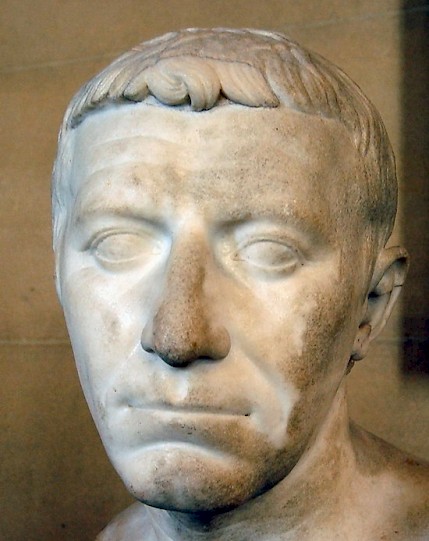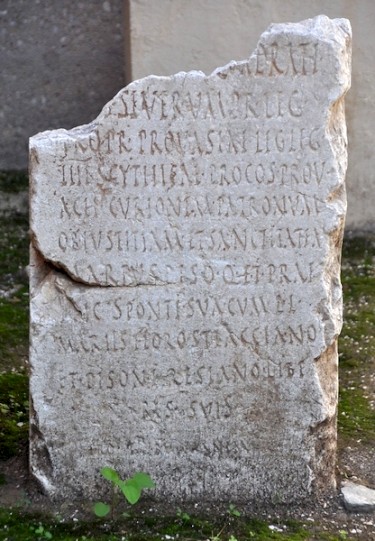Legio IIII Scythica
Legio III Scythica: one of the Roman legions. Its title means "the legion from Scythia".

This unit was founded by the triumvir Mark Antony in the years after 42. We do not know where it was first stationed. Syria is a possibility, and when this is correct, it is very likely that the fourth legion took part in Antony's ill-fated campaign against the Parthian empire. On the other hand, the surname Scythica suggests that our unit fought against the Scythians, the nomadic tribes who lived in the neighborhood of the Roman city Olbia but occasionally came to the south and tried to cross the Danube. It is likely that the fourth and fifth legions once defeated one of these tribes; but we cannot date this victory, which may have taken place later.
In 31 BCE, Caesar's adopted son Octavian defeated Mark Antony at Actium. From now on, the Roman empire was ruled by one man, Octavian, who accepted the title of Augustus. From now on, the fourth legion was certainly active in Moesia, the region of the Lower Danube. The surname Scythica is attested during the reign of Augustus, and there was much heavy fighting in the years 29-27. The Roman commander Marcus Licinius Crassus (a grandson of the triumvir) is known to have killed an enemy leader in single combat. The legion's base was probably at Viminacium (Kostolac in eastern Serbia).

Between 6 and 9 CE, IIII Scythica was active in the wars of Tiberius (the future emperor) against the Illyrians and Pannonians on the Middle Danube. Fighting was not the only activity of the legion. Several rock inscriptions prove the construction of roads and other works of engineering in the Danube area. The newly conquered country needed to be developed. Usually, IIII Scythica joined forces with V Macedonica. Among those who served in the legion was a young man named Titus Flavius Vespasianus, who is better known as the emperor Vespasian.
During the reign of Nero, the legion was transferred to the east. In 58-60, the Roman commander Gnaeus Domitius Corbulo launched a very successful campaign in the vassal kingdom Armenia. Using III Gallica, VI Ferrata, and X Fretensis, he captured the Armenian capitals Artaxata (south of modern Yerevan; 58) and Tigranocerta (59) and gave the Armenians a new, pro-Roman king, Tigranes (a great-grandson of the Jewish king Herod the Great). However, the Parthians placed another king on the Armenian throne, Tiridates, the brother of their king Vologases I.

Together with XII Fulminata, the fourth legion was involved in a retaliatory campaign, which was conducted by Lucius Caesennius Paetus, the governor of Cappadocia, in 62. However, the Parthians forced them into surrender at Rhandeia (winter 62/63). Later, Corbulo was able to turn the tables, and ordered Tiridates to receive his crown for the second time from the Roman emperor Nero. However, the disgraced legions IIII Scythica and XII Fulminata were not permitted to participate in this war.
From 66 on, the fourth legion was stationed in Zeugma, an important place on the river Euphrates, facing the Parthian frontier. It was still there in the third century.
During the civil war of the year 69, which was the result of the suicide of Nero, the Fourth Scythian legion sided with its former officer Vespasian, but did not see action during this war, because its fighting qualities were despised by the Roman high command. Only three years before, soldiers of IIII Scythica and VI Ferrata had been defeated, together with the main force of XII Fulminata, in an attempt to suppress the Jewish revolt. However, in 70, it was used to suppress a pogrom in Antioch.

Among the officers involved must have been the most famous soldier of IIII Scythica: Tiberius Julius Celsus Polemaeanus, to whom the famous library in Ephesus was dedicated. Soldiers of this legion were also employed to build a canal at Seleucia.
Between 132 and 136, subunits of this legion fought against the Jews when they revolted under Simon ben Kosiba (more).
Because Zeugma is at the border between the Roman and Parthian empires, we can be certain that the Fourth took part in all wars between the two states: for example, that of Trajan in 114-117 and that of Lucius Verus between 161 and 166, which culminated in the sack of the Parthian capital Ctesiphon.
Between 181 and 183, the commander of IIII Scythica was the future emperor Lucius Septimius Severus (193-211). He used the fourth legion during his campaign against the Parthians in 194. In 197-198, the Scythian legion took part in Severus' second Parthian war. Again, the soldiers of the Fourth sacked Ctesiphon. This time, the Parthian empire did not recover from the blow. Within a generation, it had been replaced by the powerful kingdom of the Persian Sasanians.

Probably, IIII Scythica was somehow involved in the eastern campaign of Caracalla, who died at Harran (in 217) and must have passed through Zeugma. In 219, the legion's commander Gellius Maximus revolted against the emperor Heliogabalus, but he was swiftly removed.
After this incident, the legion disappears from our sources. However, it is very likely that it still existed, because it is mentioned in an early fifth-century document (the Notitia Dignitatum). At that moment, the Fourth Scythian legion was still part of the army of Syria, although it was no longer at Zeugma. The transfer to another (still unidentified) base is usually attributed to the emperor Diocletian.
A hypothetical history of the Fourth must mention that it took part in the war waged by Severus Alexander against the Sasanians. They had invaded the Roman empire in 230 and had installed an emperor in Emessa, but Severus Alexander was able to restore order and invade Mesopotamia. In 244, the Romans again invaded Iraq, but their emperor Gordian III died and was succeeded by Philippus Arabs, who owed his throne to the Sasanian king Shapur I.
Even worse was to come. In 256 Shapur captured Satala (the fortress of XV Apollinaris), and two years later he sacked Trapezus. When the Roman emperor Valerian tried to restore order and invaded Mesopotamia, he was defeated and captured. Captive Roman soldiers were ordered to build a bridge at modern Shushtar. These Roman defeats are commemorated on several Sasanian monuments.
However, under the emperors Odaenathus of Palmyra (261-267) and Diocletian (284-305), the Romans restored their fortunes and in 298, a peace treaty was concluded in which the Persians had to give up territories in northern Mesopotamia. The Fourth Scythian Legion must have played a role during these campaigns, but we have almost no information about them - except for the fact that it survived into the fourth century.
The emblem of IIII Scythica was the Capricorn.
Literature
- J. Bennett, "Two New Centurions of the legio IIII Scythica," in: Latomus, 66 (2007) 404-413
- J. Bennett, "A Centurion and His Slave: A Latin Epitaph from Western Anatolia in the Rijksmuseum van Oudheden, Leiden" in: Anatolica 33 (2007) 129-142
- H. Devijver, "Commanders and Officers of Legio IIII Scythica", in: D.L. Kennedy (ed.), The Twin Towns of Zeugma on the Euphrates (1998), 205-232
- D. French, "Recruitment in Asia Minor for the Legio IIII Scythica", in: S. Mitchell (ed.), Armies and Frontiers in Roman and Byzantine Anatolia (1983) 47-59
- M.A. Speidel, "Legio IV Scythica", in: Yann Le Bohec, Les légions de Rome sous le Haut-Empire (2000 Lyon) 327-337
- J. Wagner, "Legio IV Scythica in Zeugma am Euphrat", in: Studien zu den Militärgrenzen Roms 2 (1977) 517-539
- article by Emil Ritterling.